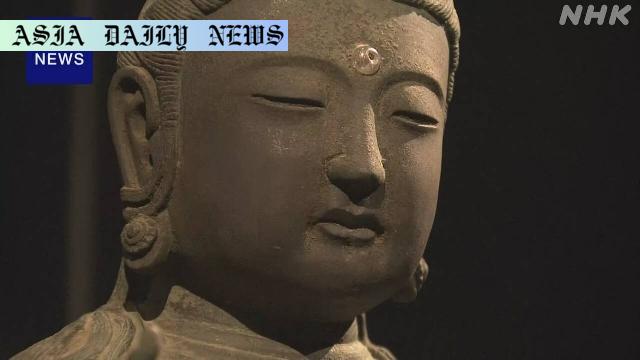Buddhist statue: A stolen artifact returned from South Korea is now on display in southwestern Japan, symbolizing restored ties.

The Significance of the Buddhist Statue’s Return
The Buddhist statue, which holds significant historical and cultural importance, has taken center stage in Nagasaki Prefecture following its return from South Korea. The artifact has become a symbol of restored faith and cultural connections, especially since it was stolen from the Kannonji Temple on Tsushima Island in 2012. After being discovered in South Korea and undergoing legal proceedings, its recent return marks the end of a challenging 13-year journey. The decision to display the statue at the Tsushima Museum underscores its importance as not only a cultural asset but also as a medium for fostering goodwill between Japan and South Korea.
Designated by Nagasaki Prefecture as a tangible cultural asset, the statue’s absence had left a void in the local community. Upon its return, the prefecture ensured extra security for the artifact, housing it safely at the Tsushima Museum. This effort reflects the value placed on the artifact and the need to preserve it for future generations. The exhibition offers visitors a beautiful opportunity to connect with the artifact, which represents centuries of history and craftsmanship.
Enhanced Cultural Unity and Renewed International Relations
The return of the Buddhist statue has ignited hope for better relations between Japan and South Korea. With both nations sharing a rich tapestry of cultural and historical connections, the artifact serves as a reminder of their shared heritage. Leaders and cultural advocates on both sides see this as a symbolic gesture for fostering mutual understanding and collaboration. Murase Tatsuma, head of a group supporting the Kannonji Temple, regards the return as pivotal, envisioning it as a pathway for bolstering unity and trust between these Asian neighbors.
Visitors to the exhibition expressed excitement and emotion upon witnessing the statue. A woman in her 60s from Tsushima conveyed her disbelief and joy at seeing the artifact returned to its rightful place. These personal experiences enrich the significance of the event, emphasizing its emotional and cultural resonance. The exhibition, running through June 15, invites people from all walks of life to engage directly with this precious piece of history.
The Exhibition: A Bridge to Historical Awareness
The special exhibition at the Tsushima Museum has drawn national attention, with art enthusiasts, historians, and local residents flocking to see the returned statue. On its opening day, approximately 20 eager individuals gathered early in the morning, a testament to how deeply the artifact resonates with the community. Visitors marveled at its exquisite design and intricate craftsmanship, appreciating its significance from multiple angles. Many used the opportunity to document the moment through photographs, sharing their experiences and spreading awareness.
Security concerns have been prioritized to ensure the safety of the item, with additional measures implemented by the museum authorities. This reflects not just the fragility of the artifact, but also the seriousness with which the community values its preservation. As the exhibition progresses, it offers people an opportunity to learn about the history, symbolism, and spiritual significance this artifact holds, encouraging a deeper appreciation for cultural heritage.
The Hope for Stronger Bilateral Relations
The successful return and display of the Buddhist statue have fueled discussions about how cultural exchanges can help strengthen bilateral ties. The sentiment expressed during the exhibition is one of hope — hope for healing, collaboration, and mutual respect between Japan and South Korea. Cultural artifacts often hold the power to erase borders and divisions, and this statue has emerged as a powerful symbol of that potential. Leaders, curators, and citizens alike hope that such gestures will pave the way for constructive dialogue and a shared commitment to preserving cultural heritage.
The process of repatriating the statue serves as a case study in international cooperation, reflecting the complex negotiations and goodwill required to resolve such issues. This sense of collaboration and mutual respect can serve as a foundation for addressing other shared challenges. Ultimately, the exhibition symbolizes a step forward in preserving history while looking toward a united future between the two nations.
Commentary
The Symbolism of the Statue
The return of the Buddhist statue to Japan is a triumph not just for cultural preservation but for global diplomacy. Artifacts carry stories of the past, and this particular piece bridges a historical connection between Japan and South Korea. Its journey back to its place of origin is symbolic of resilience, reminding us that even the most significant treasures can endure through adversity. The statue’s presence in a museum brings a sense of calming closure to both the local community and the artifact itself, which has been admired for centuries.
A Story of Gratitude and Reconnection
What resonates most with the return of the statue is the overwhelming gratitude expressed by the citizens and leaders on Tsushima Island. It speaks volumes about the emotional and cultural weight of such artifacts. Witnessing the joy and disbelief of the locals is a powerful reminder of how deeply these treasures are intertwined with their communities. For the older generation particularly, the return of the artifact is a chance to reconnect with elements of their heritage that they feared might be lost forever.
A Path Forward: Reinventing Cultural Collaborations
While the return of the Buddhist statue is cause for celebration, it also raises important questions about the future of international cultural exchange and preservation. This event underscores the need for cooperation, respect, and urgency in returning stolen artifacts. It also highlights how shared efforts can act as a bridge in fostering closer ties between two nations separated by history. By working on cultural initiatives together, countries can create spaces that foster understanding and trust. The exhibition stands as an emblem of hope for what can be achieved when history, heritage, and humanity are treated with respect.


